Thermal Dynamics 42 CUTMASTER Mode d'emploi
- Catégorie
- Système de soudage
- Taper
- Mode d'emploi

40
AMP
1
DC
PHASE
Art # A-09347_AE
PLASMA CUTTING SYSTEM
42
CUTMASTER
™
Rev. AD Date: November 22, 2011 Manual # 0-5141
Operating Features:
Operating Manual

WE APPRECIATE YOUR BUSINESS!
Congratulations on your new Thermal Dynamics product. We
are proud to have you as our customer and will strive to provide
you with the best service and reliability in the industry. This
product is backed by our extensive warranty and world-wide
service network. To locate your nearest distributor or service
provider visit us on the web at www.cigweld.com.au (Asia
Pacific) www.thermal-dynamics.com (Americas and Europe).
This Operating Manual has been designed to instruct you on the
correct use and operation of your Thermal Dynamics product. Your
satisfaction with this product and its safe operation is our ultimate
concern. Therefore please take the time to read the entire manual,
especially the Safety Precautions. They will help you to avoid
potential hazards that may exist when working with this product.
YOU ARE IN GOOD COMPANY!
The Brand of Choice for Contractors and Fabricators Worldwide.
Thermal Dynamics is a Global Brand of manual and automation
Plasma Cutting Products for Thermadyne Industries Inc.
We distinguish ourselves from our competition through market-
leading, dependable products that have stood the test of time.
We pride ourselves on technical innovation, competitive prices,
excellent delivery, superior customer service and technical support,
together with excellence in sales and marketing expertise.
Above all, we are committed to developing technologically
advanced products to achieve a safer working environment within
the welding industry.

!
WARNINGS
Read and understand this entire Manual and your employer’s safety practices before installing, operat-
ing, or servicing the equipment.
While the information contained in this Manual represents the Manufacturer's best judgement, the
Manufacturer assumes no liability for its use.
Plasma Cutting Power Supply
CutMaster™ 42
SL40 Torch™
Operating Manual Number 0-5141
Published by:
Thermal Dynamics Corporation
82 Benning Street
West Lebanon, New Hampshire, USA 03784
(603) 298-5711
www.thermal-dynamics.com
Copyright 2010, 2011 by
Thermadyne Corporation
All rights reserved.
Reproduction of this work, in whole or in part, without written permission of the publisher is
prohibited.
The publisher does not assume and hereby disclaims any liability to any party for any loss or
damage caused by any error or omission in this Manual, whether such error results from negli-
gence, accident, or any other cause.
Printed in the United States of America
Publication Date: October 15, 2010
Revision AD Date: November 22, 2011
Record the following information for Warranty purposes:
Where Purchased:_______________________________ __________________
Purchase Date:__________________________________ __________________
Power Supply Serial #:___________________________ ___________________
Torch Serial #:___________________________________ _________________
i

TABLE OF CONTENTS

TABLE OF CONTENTS
SECTION 1:
GENERAL INFORMATION ................................................................................................................ 1-1
1.01 Notes, Cautions and Warnings ................................................................................. 1-1
1.02 Important Safety Precautions ................................................................................... 1-1
1.03 Publications .............................................................................................................. 1-3
1.04 Note, Attention et Avertissement .............................................................................. 1-4
1.05 Precautions De Securite Importantes ....................................................................... 1-4
1.06 Documents De Reference ......................................................................................... 1-6
1.07 Declaration of Conformity......................................................................................... 1-7
1.08 Statement of Warranty ............................................................................................. 1-8
SECTION 2 SYSTEM:
INTRODUCTION .............................................................................................................................. 2-1
2.01 Working Principle ..................................................................................................... 2-1
2.02 Power Supply Specifications .................................................................................... 2-1
2.03 Input Wiring Specifications ...................................................................................... 2-2
2.04 Power Supply Features ............................................................................................. 2-3
2.05 Torch Specifications ................................................................................................. 2-4
SECTION 2TORCH:
INTRODUCTION ............................................................................................................................ 2T-1
2T.01 Scope of Manual..................................................................................................... 2T-1
2T.02 Specifications ........................................................................................................ 2T-1
2T.03 Introduction to Plasma ........................................................................................... 2T-2
SECTION 3:
INSTALLATION ................................................................................................................................ 3-1
3.01 Unpacking ................................................................................................................ 3-1
3.02 Lifting Options .......................................................................................................... 3-1
3.03 Primary Input Power Connections ............................................................................ 3-2
SECTION 4 SYSTEM:
OPERATION ..................................................................................................................................... 4-1
4.01 Control Panel ............................................................................................................ 4-1
4.02 Preparations For Operating....................................................................................... 4-2
4.03 Sequence of Operation ............................................................................................. 4-4
4.04 Cut Quality ................................................................................................................ 4-6
4.05 General Cutting Information ..................................................................................... 4-7
SECTION 5 SYSTEM: SERVICE ................................................................................................................. 5-1
5.01 General Maintenance ................................................................................................ 5-1
5.02 Basic Troubleshooting Guide .................................................................................... 5-2
SECTION 5 TORCH:
SERVICE ........................................................................................................................................ 5T-1
5T.01 General Maintenance .............................................................................................. 5T-1
5T.02 Inspection and Replacement of Consumable Torch Parts ....................................... 5T-1

TABLE OF CONTENTS
SECTION 6:
PARTS LISTS ................................................................................................................................... 6-1
6.01 Introduction .............................................................................................................. 6-1
6.02 Power Supply Replacement Parts ............................................................................ 6-2
APPENDIX 1:
CIRCUIT DIAGRAM ..........................................................................................................................A-1

CUTMASTER 42
Manual 0-5141 1-1 GENERAL INFORMATION
SECTION 1:
GENERAL INFORMATION
1.01 Notes, Cautions and Warnings
Throughout this manual, notes, cautions, and warnings are used to
highlight important information. These highlights are categorized as
follows:
NOTE
An operation, procedure, or background information
which requires additional emphasis or is helpful in ef-
ficient operation of the system.
CAUTION
A procedure which, if not properly followed, may cause
damage to the equipment.
!
WARNING
A procedure which, if not properly followed, may cause
injury to the operator or others in the operating area.
1.02 Important Safety Precautions
!
WARNING
OPERATION AND MAINTENANCE OF PLASMA ARC
EQUIPMENT CAN BE DANGEROUS AND HAZARDOUS
TO YOUR HEALTH.
Plasma arc cutting produces intense electric and magnet-
ic emissions that may interfere with the proper function
of cardiac pacemakers, hearing aids, or other electronic
health equipment. Persons who work near plasma arc
cutting applications should consult their medical health
professional and the manufacturer of the health equip-
ment to determine whether a hazard exists.
To prevent possible injury, read, understand and follow
all warnings, safety precautions and instructions before
using the equipment. Call 1-603-298-5711 or your local
distributor if you have any questions.
GASES AND FUMES
Gases and fumes produced during the plasma cutting process can be
dangerous and hazardous to your health.
• Keepallfumesandgasesfromthebreathingarea.Keepyour
head out of the welding fume plume.
• Useanair-suppliedrespiratorifventilationisnotadequateto
remove all fumes and gases.
• Thekindsoffumesandgasesfromtheplasmaarcdependon
the kind of metal being used, coatings on the metal, and the
different processes. You must be very careful when cutting
or welding any metals which may contain one or more of the
following:
Antimony Chromium Mercury
Arsenic Cobalt Nickel
Barium Copper Selenium
Beryllium Lead Silver
Cadmium Manganese Vanadium
• AlwaysreadtheMaterialSafetyDataSheets(MSDS)thatshould
be supplied with the material you are using. These MSDSs
will give you the information regarding the kind and amount of
fumes and gases that may be dangerous to your health.
• Forinformationonhowtotestforfumesandgasesinyour
workplace, refer to item 1 in Subsection 1.03, Publications in
this manual.
• Usespecialequipment,suchaswaterordowndraftcutting
tables, to capture fumes and gases.
• Donotusetheplasmatorchinanareawherecombustibleor
explosive gases or materials are located.
• Phosgene,atoxicgas,isgeneratedfromthevaporsofchlo-
rinated solvents and cleansers. Remove all sources of these
vapors.
• Thisproduct, when used for welding or cutting, produces
fumes or gases which contain chemicals known to the State
of California to cause birth defects and, in some cases, cancer.
(California Health & Safety Code Sec. 25249.5 et seq.)
ELECTRIC SHOCK
Electric Shock can injure or kill. The plasma arc process uses and
produces high voltage electrical energy. This electric energy can cause
severe or fatal shock to the operator or others in the workplace.
• Nevertouchanypartsthatareelectrically“live”or“hot.”
• Weardryglovesandclothing.Insulateyourselffromthework
piece or other parts of the welding circuit.
• Repairorreplaceallwornordamagedparts.
• Extracaremustbetakenwhen the workplace is moist or
damp.
• InstallandmaintainequipmentaccordingtoNECcode,referto
item 9 in Subsection 1.03, Publications.
• Disconnect power source before performingany serviceor
repairs.
• ReadandfollowalltheinstructionsintheOperatingManual.
FIRE AND EXPLOSION
Fire and explosion can be caused by hot slag, sparks, or the plasma
arc.
• Besurethereisnocombustibleorammablematerialinthe
workplace. Any material that cannot be removed must be
protected.
• Ventilateallammable or explosive vapors from the work-
place.
• Donotcutorweldoncontainersthatmayhaveheldcombus-
tibles.

CUTMASTER 42
GENERAL INFORMATION 1-2 Manual 0-5141
• Providearewatchwhenworkinginanareawhererehazards
may exist.
• Hydrogengas may beformedand trapped underaluminum
workpieces when they are cut underwater or while using a water
table. DO NOT cut aluminum alloys underwater or on a water
table unless the hydrogen gas can be eliminated or dissipated.
Trapped hydrogen gas that is ignited will cause an explosion.
NOISE
Noise can cause permanent hearing loss. Plasma arc processes can
cause noise levels to exceed safe limits. You must protect your ears
from loud noise to prevent permanent loss of hearing.
• Toprotectyourhearingfromloudnoise,wearprotectiveear
plugs and/or ear muffs. Protect others in the workplace.
• Noiselevelsshouldbemeasuredtobesurethedecibels(sound)
do not exceed safe levels.
• Forinformationonhowtotestfornoise,seeitem1inSubsec-
tion 1.03, Publications, in this manual.
LEAD WARNING
This product contains chemicals, including lead, or otherwise
produces chemicals known to the State of California to cause
cancer, birth defects and other reproductive harm. Wash hands
after handling. (California Health & Safety Code § 25249.5 et seq.)
PLASMA ARC RAYS
Plasma Arc Rays can injure your eyes and burn your skin. The plasma
arc process produces very bright ultra violet and infrared light. These
arc rays will damage your eyes and burn your skin if you are not
properly protected.
• Toprotectyoureyes,alwayswearaweldinghelmetorshield.
Also always wear safety glasses with side shields, goggles or
other protective eye wear.
• Wearweldingglovesandsuitableclothingtoprotectyourskin
from the arc rays and sparks.
• Keephelmetand safetyglassesin goodcondition. Replace
lenses when cracked, chipped or dirty.
• Protectothersintheworkareafromthearcrays.Useprotective
booths, screens or shields.
• Usetheshadeoflensassuggestedinthefollowingchart.
NOTE
These values apply where the actual arc is clearly
seen. Experience has shown that lighter filters may
be used when the arc is hidden by the workpiece.
AWS F2.2:2001 (R2010), Adapted with permission of the American Welding Society (AWS), Miami, Florida
Guide for Shade Numbers
(from AWS F2.2, Lens Shade Selector)
Shade numbers are given as a guide only and may be varied to suit individual needs.
Process Electrode Size in. (mm)
Arc Current
(Amperes)
Minimum
Protective
Shade
Suggested*
Shade No.
(Comfort)
Shielded Metal Arc Welding (SMAW)
Less than 3/32 (2.4)
3/32-5/32 (2.4-4.0)
5/32-1/4 (4.0-6.4)
More than 1/4 (6.4)
Less than 60
60-160
160-250
250-550
7
8
10
11
-
10
12
14
Gas Metal Arc Weding (GMAW) and
Flux Cored Arc Welding (FCAW)
Less than 60
60-160
160-250
250-550
7
10
10
10
-
11
12
14
Gas Tungsten arc Welding (GTAW)
Less than 50
50-150
150-500
8
8
10
10
12
14
Air Carbon Arc Cutting (CAC-A)
(Light)
(Heavy)
Less than 500
500-1000
10
11
12
14
Plasma Arc Welding (PAW)
Less than 20
20-100
100-400
400-800
6
8
10
11
6 to 8
10
12
14
Plasma Arc Cutting (PAC)
Less than 20
20-40
40-60
60-80
80-300
300-400
400-800
4
5
6
8
8
9
10
4
5
6
8
9
12
14
* As a rule of thumb, start with a shade that is too dark to see the weld zone. Then go to a lighter shade
which gives sufficient view of the weld zone without going below the minimum. In oxyfuel gas welding,
cutting,orbrazingwherethetorchand/ortheuxproducesahighyellowlight,itisdesirabletousea
filter lens that absorbs the yellow or soduim line of the visible light spectrum.
Table 1-1

CUTMASTER 42
Manual 0-5141 1-3 GENERAL INFORMATION
1.03 Publications
Refer to the following standards or their latest revisions for more
information:
1. OSHA, SAFETY AND HEALTH STANDARDS, 29CFR 1910, obtain-
able from the Superintendent of Documents, U.S. Government
Printing Office, Washington, D.C. 20402
2. ANSI Standard Z49.1, SAFETY IN WELDING AND CUTTING, ob-
tainable from the American Welding Society, 550 N.W. LeJeune
Rd, Miami, FL 33126
3. NIOSH, SAFETY AND HEALTH IN ARC WELDING AND GAS
WELDING AND CUTTING, obtainable from the Superintendent of
Documents, U.S. Government Printing Office, Washington, D.C.
20402
4. ANSI Standard Z87.1, SAFE PRACTICES FOR OCCUPATION AND
EDUCATIONAL EYE AND FACE PROTECTION, obtainable from
American National Standards Institute, 1430 Broadway, New York,
NY 10018
5. ANSI Standard Z41.1, STANDARD FOR MEN’S SAFETY-TOE
FOOTWEAR, obtainable from the American National Standards
Institute, 1430 Broadway, New York, NY 10018
6. ANSI Standard Z49.2, FIRE PREVENTION IN THE USE OF CUTTING
AND WELDING PROCESSES, obtainable from American National
Standards Institute, 1430 Broadway, New York, NY 10018
7. AWS Standard A6.0, WELDING AND CUTTING CONTAINERS
WHICH HAVE HELD COMBUSTIBLES, obtainable from American
Welding Society, 550 N.W. LeJeune Rd, Miami, FL 33126
8. NFPA Standard 51, OXYGEN-FUEL GAS SYSTEMS FOR WELD-
ING, CUTTING AND ALLIED PROCESSES, obtainable from the
National Fire Protection Association, Batterymarch Park, Quincy,
MA 02269
9. NFPA Standard 70, NATIONAL ELECTRICAL CODE, obtainable
from the National Fire Protection Association, Batterymarch Park,
Quincy, MA 02269
10. NFPA Standard 51B, CUTTING AND WELDING PROCESSES,
obtainable from the National Fire Protection Association, Bat-
terymarch Park, Quincy, MA 02269
11. CGA Pamphlet P-1, SAFE HANDLING OF COMPRESSED GASES
IN CYLINDERS, obtainable from the Compressed Gas Association,
1235 Jefferson Davis Highway, Suite 501, Arlington, VA 22202
12. CSA Standard W117.2, CODE FOR SAFETY IN WELDING AND
CUTTING, obtainable from the Canadian Standards Association,
Standards Sales, 178 Rexdale Boulevard, Rexdale, Ontario, Canada
M9W 1R3
13. NWSA booklet, WELDING SAFETY BIBLIOGRAPHY obtainable
from the National Welding Supply Association, 1900 Arch Street,
Philadelphia, PA 19103
14. American Welding Society Standard AWSF4.1, RECOMMENDED
SAFE PRACTICES FOR THE PREPARATION FOR WELDING AND
CUTTING OF CONTAINERS AND PIPING THAT HAVE HELD HAZ-
ARDOUS SUBSTANCES, obtainable from the American Welding
Society, 550 N.W. LeJeune Rd, Miami, FL 33126
15. ANSI Standard Z88.2, PRACTICE FOR RESPIRATORY PROTEC-
TION, obtainable from American National Standards Institute, 1430
Broadway, New York, NY 10018

CUTMASTER 42
GENERAL INFORMATION 1-4 Manual 0-5141
1.04 Note, Attention et Avertissement
Danscemanuel,lesmots“note,”“attention,”et“avertissement”
sont utilisés pour mettre en relief des informations à caractère
important. Ces mises en relief sont classifiées comme suit :
NOTE
Toute opération, procédure ou renseignement général sur
lequel il importe d’insister davantage ou qui contribue à
l’efficacité de fonctionnement du système.
ATTENTION
Toute procédure pouvant résulter l’endommagement
du matériel en cas de non-respect de la procédure en
question.
!
AVERTISSEMENT
Toute procédure pouvant provoquer des blessures de
l’opérateur ou des autres personnes se trouvant dans
la zone de travail en cas de non-respect de la procédure
en question.
1.05 Precautions De Securite
Importantes
!
AVERTISSEMENTS
L’OPÉRATION ET LA MAINTENANCE DU MATÉRIEL
DE SOUDAGE À L’ARC AU JET DE PLASMA PEUVENT
PRÉSENTER DES RISQUES ET DES DANGERS DE
SANTÉ.
Coupant à l’arc au jet de plasma produit de l’énergie
électrique haute tension et des émissions magnétique qui
peuventinterférerlafonctionpropred’un“pacemaker”
cardiaque, les appareils auditif, ou autre matériel de santé
electronique. Ceux qui travail près d’une application à
l’arc au jet de plasma devrait consulter leur membre pro-
fessionel de médication et le manufacturier de matériel de
santé pour déterminer s’il existe des risques de santé.
Il faut communiquer aux opérateurs et au personnel
TOUS les dangers possibles. Afin d’éviter les blessures
possibles, lisez, comprenez et suivez tous les avertisse-
ments, toutes les précautions de sécurité et toutes les
consignes avant d’utiliser le matériel. Composez le +
603-298-5711 ou votre distributeur local si vous avez
des questions.
FUMÉE et GAZ
La fumée et les gaz produits par le procédé de jet de plasma peuvent
présenter des risques et des dangers de santé.
• Eloigneztoutefuméeetgazdevotrezonederespiration.Gardez
votre tête hors de la plume de fumée provenant du chalumeau.
• Utilisezunappareilrespiratoireàalimentationenairsil’aération
fournie ne permet pas d’éliminer la fumée et les gaz.
• Les sortes de gaz et de fumée provenant de l’arc de plasma
dépendent du genre de métal utilisé, des revêtements se trouvant
sur le métal et des différents procédés. Vous devez prendre soin
lorsque vous coupez ou soudez tout métal pouvant contenir un
ou plusieurs des éléments suivants:
antimoine cadmium mercure
argent chrome nickel
arsenic cobalt plomb
baryum cuivre sélénium
béryllium manganèse vanadium
• Liseztoujoursleschesdedonnéessurlasécuritédesmatières
(sigleaméricain“MSDS”);celles-cidevraientêtrefourniesavec
le matériel que vous utilisez. Les MSDS contiennent des rensei-
gnements quant à la quantité et la nature de la fumée et des gaz
pouvant poser des dangers de santé.
• Pourdesinformationssurlamanièredetesterlafuméeetlesgaz
de votre lieu de travail, consultez l’article 1 et les documents cités
à la page 5.
• Utilisezunéquipementspécialtelquedestablesdecoupeàdébit
d’eau ou à courant descendant pour capter la fumée et les gaz.
• N’utilisezpaslechalumeauaujetdeplasmadansunezoneoùse
trouvent des matières ou des gaz combustibles ou explosifs.
• Lephosgène,ungaztoxique,estgénéréparlafuméeprovenant
des solvants et des produits de nettoyage chlorés. Eliminez toute
source de telle fumée.
• Ceproduit,dansleprocéderdesoudageetdecoupe,produitde
la fumée ou des gaz pouvant contenir des éléments reconnu dans
L’état de la Californie, qui peuvent causer des défauts de naissance
et le cancer. (La sécurité de santé en Californie et la code sécurité
Sec. 25249.5 et seq.)
CHOC ELECTRIQUE
Les chocs électriques peuvent blesser ou même tuer. Le procédé
au jet de plasma requiert et produit de l’énergie électrique haute
tension. Cette énergie électrique peut produire des chocs graves,
voire mortels, pour l’opérateur et les autres personnes sur le lieu de
travail.
• Netouchezjamaisunepièce“soustension”ou“vive”;portezdes
gants et des vêtements secs. Isolez-vous de la pièce de travail ou
des autres parties du circuit de soudage.
• Réparezouremplaceztoutepièceuséeouendommagée.
• Prenezdessoinsparticulierslorsquelazonedetravailesthumide
ou moite.
• MontezetmaintenezlematérielconformémentauCodeélectrique
national des Etats-Unis. (Voir la page
5,
article 9.)
• Débranchezl’alimentationélectriqueavanttouttravaild’entretien
ou de réparation.
• Lisez et respecteztoutes les consignesdu Manuel de
consignes.

CUTMASTER 42
Manual 0-5141 1-5 GENERAL INFORMATION
INCENDIE ET EXPLOSION
Les incendies et les explosions peuvent résulter des scories chaudes,
des étincelles ou de l’arc de plasma. Le procédé à l’arc de plasma
produit du métal, des étincelles, des scories chaudes pouvant
mettre le feu aux matières combustibles ou provoquer l’explosion de
fumées inflammables.
• Soyezcertainqu’aucunematièrecombustibleou inflammable
ne se trouve sur le lieu de travail. Protégez toute telle matière
qu’il est impossible de retirer de la zone de travail.
• Procurezunebonneaérationdetouteslesfuméesinflammables
ou explosives.
• Necoupezpasetnesoudezpaslesconteneursayantpu
renfermer des matières combustibles.
• Prévoyezuneveilled’incendielorsdetouttravaildansunezone
présentant des dangers d’incendie.
• Legashydrogènepeutseformerous’accumulersousles
pièces de travail en aluminium lorsqu’elles sont coupées sous
l’eau ou sur une table d’eau. NE PAS couper les alliages en
aluminium sous l’eau ou sur une table d’eau à moins que le gas
hydrogène peut s’échapper ou se dissiper. Le gas hydrogène
accumulé explosera si enflamm
é.
RAYONS D’ARC DE PLASMA
Les rayons provenant de l’arc de plasma peuvent blesser vos yeux et
brûler votre peau. Le procédé à l’arc de plasma produit une lumière
infra-rouge et des rayons ultra-violets très forts. Ces rayons d’arc
nuiront à vos yeux et brûleront votre peau si vous ne vous protégez
pas correctement.
• Pour protéger vos yeux, portez toujours un casque ou un
écran de soudeur. Portez toujours des lunettes de sécurité
munies de parois latérales ou des lunettes de protection ou
une autre sorte de protection oculaire.
• Portezdesgantsdesoudeuretunvêtementprotecteur
approprié pour protéger votre peau contre les étincelles et
les rayons de l’arc.
• Maintenezvotrecasqueetvoslunettesdeprotectionenbon
état. Remplacez toute lentille sale ou comportant fissure ou
rognure.
• Protégezles autres personnessetrouvantsur la zonede
travail contre les rayons de l’arc en fournissant des cabines
ou des écrans de protection.
• Utilisezlanuancedelentillequiestsuggèréedansle
recommendation qui suivent ANSI/ASC Z49.1:
Nuance Minimum Nuance Suggerée
Courant Arc Protective Numéro Numéro
Moins de 300* 8 9
300 - 400* 9 12
400 - 800* 10 14
* Ces valeurs s’appliquent ou l’arc actuel est observé
clairement. L’experience a démontrer que les filtres
moins foncés peuvent être utilisés quand l’arc est
caché par moiceau de travail.
BRUIT
Le bruit peut provoquer une perte permanente de l’ouïe. Les procédés
de soudage à l’arc de plasma peuvent provoquer des niveaux sonores
supérieurs aux limites normalement acceptables. Vous dú4ez vous
protéger les oreilles contre les bruits forts afin d’éviter une perte
permanente de l’ouïe.
• Pourprotégervotreouïecontrelesbruitsforts,portezdes
tampons protecteurs et/ou des protections auriculaires. Pro-
tégez également les autres personnes se trouvant sur le lieu
de travail.
• Ilfaut mesurer les niveaux sonores an d’assurer queles
décibels (le bruit) ne dépassent pas les niveaux sûrs.
• Pourdesrenseignementssurlamanièredetesterlebruit,
consultez l’article 1, page 5.
PLOMB AVERTISSEMENT
Ce produit contient des produits chimiques, comme le plomb,
ou engendre des produits chimiques, reconnus par l’état
de Californie comme pouvant être à l’origine de cancer, de
malformations fœtales ou d’autres problèmes de reproduction.
Il faut se laver les mains après toute manipulation.
(Code de Californie de la sécurité et santé, paragraphe 25249.5 et
suivants)

CUTMASTER 42
GENERAL INFORMATION 1-6 Manual 0-5141
1.06 Documents De Reference
Consultez les normes suivantes ou les révisions les plus récentes
ayant été faites à celles-ci pour de plus amples renseignements :
1. OSHA, NORMES DE SÉCURITÉ DU TRAVAIL ET DE
PROTECTION DE LA SANTÉ, 29CFR 1910, disponible auprès du
Superintendent of Documents, U.S. Government Printing Office,
Washington, D.C. 20402
2. Norme ANSI Z49.1, LA SÉCURITÉ DES OPÉRATIONS DE COUPE
ET DE SOUDAGE, disponible auprès de la Société Américaine de
Soudage (American Welding Society), 550 N.W. LeJeune Rd.,
Miami, FL 33126
3. NIOSH, LA SÉCURITÉ ET LA SANTÉ LORS DES OPÉRATIONS
DE COUPE ET DE SOUDAGE À L’ARC ET AU GAZ, disponible
auprès du Superintendent of Documents, U.S. Government
Printing Office, Washington, D.C. 20402
4. Norme ANSI Z87.1, PRATIQUES SURES POUR LA PROTECTION
DES YEUX ET DU VISAGE AU TRAVAIL ET DANS LES ECOLES,
disponible de l’Institut Américain des Normes Nationales
(American National Standards Institute), 1430 Broadway, New
York, NY 10018
5. Norme ANSI Z41.1, NORMES POUR LES CHAUSSURES
PROTECTRICES, disponible auprès de l’American National
Standards Institute, 1430 Broadway, New York, NY 10018
6. Norme ANSI Z49.2, PRÉVENTION DES INCENDIES LORS DE L’
EMPLOI DE PROCÉDÉS DE COUPE ET DE SOUDAGE, disponible
auprès de l’American National Standards Institute, 1430
Broadway, New York, NY 10018
7. Norme A6.0 de l’Association Américaine du Soudage (AWS), LE
SOUDAGE ET LA COUPE DE CONTENEURS AYANT RENFERMÉ
DES PRODUITS COMBUSTIBLES, disponible auprès de la
American Welding Society, 550 N.W. LeJeune Rd., Miami, FL
33126
8. Norme 51 de l’Association Américaine pour la Protection
contre les Incendies (NFPA), LES SYSTEMES À GAZ AVEC
ALIMENTATION EN OXYGENE POUR LE SOUDAGE, LA COUPE
ET LES PROCÉDÉS ASSOCIÉS, disponible auprès de la National
Fire Protection Association, Batterymarch Park, Quincy, MA
02269
9. Norme 70 de la NFPA, CODE ELECTRIQUE NATIONAL,
disponible auprès de la National Fire Protection Association,
Batterymarch Park, Quincy, MA 02269
10. Norme 51B de la NFPA, LES PROCÉDÉS DE COUPE ET DE
SOUDAGE, disponible auprès de la National Fire Protection
Association, Batterymarch Park, Quincy, MA 02269
11. Brochure GCA P-1, LA MANIPULATION SANS RISQUE DES
GAZ COMPRIMÉS EN CYLINDRES, disponible auprès de l’
Association des Gaz Comprimés (Compressed Gas Association),
1235 Jefferson Davis Highway, Suite 501, Arlington, VA 22202
12. Norme CSA W117.2, CODE DE SÉCURITÉ POUR LE SOUDAGE
ET LA COUPE, disponible auprès de l’Association des Normes
Canadiennes, Standards Sales, 178 Rexdale Boulevard, Rexdale,
Ontario, Canada, M9W 1R3
13. Livret NWSA, BIBLIOGRAPHIE SUR LA SÉCURITÉ DU SOUDAGE,
disponible auprès de l’Association Nationale de Fournitures de
Soudage (National Welding Supply Association), 1900 Arch
Street, Philadelphia, PA 19103
14. Norme AWSF4.1 de l’Association Américaine de Soudage,
RECOMMANDATIONS DE PRATIQUES SURES POUR LA
PRÉPARATION À LA COUPE ET AU SOUDAGE DE CONTENEURS
ET TUYAUX AYANT RENFERMÉ DES PRODUITS DANGEREUX
, disponible auprès de la American Welding Society, 550 N.W.
LeJeune Rd., Miami, FL 33126
15. Norme ANSI Z88.2, PRATIQUES DE PROTECTION
RESPIRATOIRE, disponible auprès de l’American National
Standards Institute, 1430 Broadway, New York, NY 10018

CUTMASTER 42
Manual 0-5141 1-7 GENERAL INFORMATION
1.07 Declaration of Conformity
Manufacturer: Thermadyne Company
Address: 82 Benning Street
West Lebanon, New Hampshire 03784
USA
The equipment described in this manual conforms to all applicable aspects and regulations of the ‘Low Voltage Directive’ (European Council Directive
73/23/EEC as amended by Council Directive 93/68/EEC) and to the National legislation for the enforcement of this Directive.
The power supply equipment described in this manual conforms to CSA E60974-1 and the plasma torch equipment described in this manual
conforms to CSA E60974-7.
The equipment described in this manual conforms to all applicable aspects and regulations of the "EMC Directive" (European Council Directive
89/336/EEC) and to the National legislation for the enforcement of this Directive.
Serial numbers are unique with each individual piece of equipment and details description, parts used to manufacture a unit and date of manufacture.
National Standard and Technical Specifications
The product is designed and manufactured to a number of standards and technical requirements. Among them are:
* CSA (Canadian Standards Association) standard C22.2 number 60 for Arc welding equipment.
* UL (Underwriters Laboratory) rating 94VO flammability testing for all printed-circuit boards used.
* CENELEC EN50199 EMC Product Standard for Arc Welding Equipment.
* ISO/IEC 60974-1 (BS 638-PT10) (EN 60 974-1) (EN50192) (EN50078) applicable to plasma cutting equipment and associated accessories.
* AS60974.1 Arc Welding Equipment Welding Power Sources.
For environments with increased hazard of electrical shock, Power Supplies bearing the
S
mark conform to EN50192 when used in
conjunction with hand torches with exposed cutting tips, if equipped with properly installed standoff guides.
* Extensive product design verification is conducted at the manufacturing facility as part of the routine design and manufacturing process.
This is to ensure the product is safe, when used according to instructions in this manual and related industry standards, and performs as
specified. Rigorous testing is incorporated into the manufacturing process to ensure the manufactured product meets or exceeds all design
specifications.
Thermadyne has been manufacturing products for more than 30 years, and will continue to achieve excellence in our area of manufacture.
Manufacturers responsible representative in Europe: Steve Ward
Operations Director
Thermadyne Europe
Europa Building
Chorley N Industrial Park
Chorley, Lancashire,
England PR6 7BX
3163339
Certified to CSA
STD. E60974-1-00

CUTMASTER 42
GENERAL INFORMATION 1-8 Manual 0-5141
1.08 Statement of Warranty
LIMITED WARRANTY: Subject to the terms and conditions established below, Thermadyne Company warrants to the original retail purchaser that new
Thermal Dynamics CUTMASTER
®
plasma cutting systems sold after the effective date of this warranty are free of defects in material and workmanship.
Should any failure to conform to this warranty appear within the applicable period stated below, Thermadyne Company shall, upon notification thereof and
substantiation that the product has been stored operated and maintained in accordance with Thermadyne’s specifications, instructions, recommendations
and recognized industry practice, correct such defects by suitable repair or replacement.
This warranty is exclusive and in lieu of any warranty of merchantability or fitness for a particular purpose.
Thermadyne will repair or replace, at its discretion, any warranted parts or components that fail due to defects in material or workmanship within the
time periods set out below. Thermadyne Company must be notified within 30 days of any failure, at which time Thermadyne Company will provide
instructions on the warranty procedures to be implemented.
Thermadyne Company will honor warranty claims submitted within the warranty periods listed below. All warranty periods begin on the date of sale
of the product to the original retail customer or 1 year after sale to an authorized Thermadyne Distributor.
LIMITED WARRANTY PERIOD
Product
Power Supply Components
(Parts and Labor)
Torch and Leads
(Parts and Labor)
CUTMASTER 42 4 Year 1 Year
This warranty does not apply to:
1. Consumable Parts, such as tips, electrodes, shield cups, o - rings, starter cartridges, gas distributors, fuses, filters.
2. Equipment that has been modified by an unauthorized party, improperly installed, improperly operated or misused based upon industry standards.
In the event of a claim under this warranty, the remedies shall be, at the discretion of Thermadyne Company:
1. Repair of the defective product.
2. Replacement of the defective product.
3. Reimbursement of reasonable costs of repair when authorized in advance by Thermadyne.
4. Payment of credit up to the purchase price less reasonable depreciation based on actual use.
These remedies may be authorized by Thermadyne and are FOB West Lebanon, NH or an authorized Thermadyne service station. Product returned
for service is at the owner’s expense and no reimbursement of travel or transportation is authorized.
LIMITATION OF LIABILITY: Thermadyne Company shall not under any circumstances be liable for special or consequential damages such as, but not
limitedto,damageorlossofpurchasedorreplacementgoodsorclaimsofcustomerofdistributors(hereinafter“Purchaser”)forserviceinterruption.
The remedies of the Purchaser set forth herein are exclusive and the liability of Thermadyne with respect to any contract, or anything done in
connection therewith such as the performance or breach thereof, or from the manufacture, sale, delivery, resale, or use of the goods covered by or
furnished by Thermadyne whether arising out of contract, negligence, strict tort, or under any warranty, or otherwise, shall not, except as expressly
provided herein, exceed the price of the goods upon which liability is based.
This warranty becomes invalid if replacement parts or accessories are used which may impair the safety or performance of any Thermadyne
product.
This warranty is invalid if the Thermal Dynamics product is sold by non - authorized persons.
Effective October 15, 2010

CUTMASTER 42
Manual 0-5141 2-1 INTRODUCTION
SECTION 2 SYSTEM:
INTRODUCTION
2.01 Working Principle
Rectifier
Inverter
Transformer
Rectifier
Reduce pressure, filter
Gas valve Cutting torch
Workpiece
Compressed air
Art # A-09204_AB
2.02 Power Supply Specifications
CUTMASTER 42 Power Supply Specifications
Input Power 120 VAC (+
-
10%), 1Phase, 50/60Hz
208-230 VAC (+
-
10%), 1Phase, 50/60Hz
Output Current 20 Amps @ 120VAC, 15A
20-27 Amps @ 120VAC, 20A
20-40 Amps @ 230VAC, 20A
CUTMASTER 42 Power Supply Duty Cycle (Note 1)
Ambient Temperature 104° F (40° C)
Duty Cycle 30% @ 120VAC, 40% @ 230VAC
Rated Current 27 Amps @ 120VAC, 40 Amps @ 230V
SL40 Torch Gas Requirements (see section 2T.03)
Notes
1. Duty Cycle is the percentage of time the system can be operated without overheating. Duty cycle is re-
duced if primary input voltage (AC) is low or the DC voltage is higher than shown in this chart.
2. Air supply must be free of oil, moisture, and other contaminants. Excessive oil and moisture may cause
double-arcing, rapid tip wear, or even complete torch failure. Contaminants may cause poor cutting perfor-
mance and rapid electrode wear. Optional filters provide increased filtering capabilities.
NOTE
IEC Rating is determined as specified by the International Electro-Technical Commission. These specifica-
tions include calculating an output voltage based upon power supply rated current. To facilitate comparison
between power supplies, all manufacturers use this output voltage to determine duty cycle.
TDC Rating is determined using an output voltage representative of actual output voltage during cutting
with a TDC torch. This voltage may be more or less than IEC voltage, depending upon choice of torch,
consumables, and actual cutting operation.

CUTMASTER 42
INTRODUCTION 2-2 Manual 0-5141
Art# A-09333_AC
26lb / 11.8kg
7" (177mm)
18.5" (469.9mm)
9" (228.6mm)
CUTMASTER
®
42
120V 15A
120V 20A
230V 20A
A
24
40
20
20
30
27
Figure 2-1 Power Supply Dimensions & Weight
NOTE
Weight includes torch & leads, input power cord, and work cable with clamp.
CAUTION
Provideclearanceforproperairowthroughthepowersupply.Operationwithoutproperairowwill
inhibit proper cooling and reduce duty cycle.
2.03 Input Wiring Specifications
CUTMASTER 42 Input Power Requirements
Input Power Input Current Input Current Input Suggested Sizes (See Note)
Voltage Freq. (kVA) Max (Amps) Ieff (Amps) Fuse (Amps)
(Volts-AC) (Hz) 1-Ph 1-Ph 1-Ph 1-Ph
120 50/60 3.3 27.5 15 25
208 50/60 5.0 24 15.4 23
230 50/60 5.0 21.4 13.5 20
240 50/60 5.0 20.8 13 20
Line Voltages with Suggested Circuit Protection
Motor start fuses or thermal circuit breakers are recommended for this application. Check local requirements for your situation
in this regard.
NOTE
Refer to Local and National Codes or local authority having jurisdiction for proper wiring requirements.
Cable size is de-rated based on the Duty Cycle of the equipment.
Thesuggestedsizesarebasedonexiblepowercablewithpowerpluginstallations.
Cable conductor temperature used is 167° F (75° C).

CUTMASTER 42
Manual 0-5141 2-3 INTRODUCTION
2.04 Power Supply Features
Air Inlet
Control Panel
Torch Lead
120/230 VAC Power Source
Work Cable and Clamp
Art # A-09334_AC
CUTMASTER
®
42
120V 15A
120V 20A
230V 20A
A
24
40
20
20
30
27
Art# A-09335
Air Inlet
On/Off
Switch
Power Cord

2.05 Torch Specifications
A. Torch Configuration and Dimensions
The torch head is at 75° to the torch handle. The torch includes a torch handle and torch trigger assembly.
10.125" (257 mm)
3.75"
(95 mm)
1.17" (29 mm)
Art # A-03322_AB
Torch Configuration and Dimensions
B. Torch Leads Lengths
Leads are available in 10 ft (3 m) lengths.
C. Parts-In-Place (PIP)
Torch has built-in switch.
12 vdc circuit rating
D. Type of Cooling
Combination of ambient air and gas stream through torch.
E. SL60 Torch Ratings
(Refer to Note)
NOTE
Ratings shown apply to the SL60 Torch only. Refer to the Specifications chart on page 2T-1 for CutSkill
35A data.
F. Plasma Power Supply Used With
• Thermal Dynamics CutSkill 35A

CUTMASTER 42
Manual 0-5141 2T-1 INTRODUCTION
SECTION 2TORCH:
INTRODUCTION
2T.01 Scope of Manual
This manual contains descriptions, operating instruc-
tions and maintenance procedures for the SL40 Plasma
Cutting Torch. Service of this equipment is restricted
toproperlytrainedpersonnel;unqualiedpersonnelare
strictly cautioned against attempting repairs or adjust-
ments not covered in this manual, at the risk of voiding
the Warranty. Read this manual thoroughly. A complete
understanding of the characteristics and capabilities of
this equipment will assure the dependable operation for
which it was designed.
2T.02 Specifications
A. Torch Configurations
1. Hand Torch, Model SL40
The hand torch head is at 75° to the torch handle.
The hand torches include a torch handle and torch
trigger assembly.
8.3" (210.82mm)
2.6"
(66.04mm)
3"
(66.04mm)
Radnor Version
.96" (24.38mm)
Art # A-09336
B. Torch Leads Lengths
Hand Torches are available as follows:
• 15ft/4.6m.
C. Torch Parts
Starter Cartridge, Electrode, Tip, Shield Cup
D. Parts - In - Place (PIP)
Torch has built-in switch.
12 vdc circuit rating
E. Type Cooling
Combination of ambient air and gas stream through
torch.
F. Torch Ratings
SL40 Torch Ratings
Ambient
Temperature
104° F
40° C
Duty Cycle 100% @ 40 Amps @ 193 scfh
Maximum Current 40 Amps
Voltage (V
peak
) 500V
Arc Striking Voltage 500V
Torch Control Circuit
Voltage
24V
G. Current Ratings
SL40 Current Ratings
SL40 Torch & Leads
Up to 40 Amps, DC,
Straight Polarity
NOTE
Power Supply characteristics will determine
material thickness range.
H. Gas Requirements
SL40 Torch Gas Specications
Gas (Plasma and Secondary) Compressed Air
Minimum Input Pressure
85 psi
5.9 bar
Maximum Input Pressure 125 psi / 8.6 bar
Gas Flow
193 scfh
91 lpm
!
WARNING
This torch is not to be used with oxygen (O
2
).
This torch is not to be used with high frequency
starting systems.

CUTMASTER 42
INTRODUCTION 2T-2 Manual 0-5141
2T.03 Introduction to Plasma
A. Plasma Gas Flow
Plasma is a gas which has been heated to an extremely
high temperature and ionized so that it becomes electri-
cally conductive. The plasma arc cutting and gouging
processes use this plasma to transfer an electrical arc
to the workpiece. The metal to be cut or removed is
melted by the heat of the arc and then blown away.
While the goal of plasma arc cutting is separation of
the material, plasma arc gouging is used to remove
metals to a controlled depth and width.
In a Plasma Cutting Torch a cool gas enters Zone B,
where a arc between the electrode and the torch tip
heats and ionizes the gas. The main cutting arc then
transfers to the workpiece through the column of
plasma gas in Zone C.
By forcing the plasma gas and electric arc through a
small orifice, the torch delivers a high concentration
of heat to a small area. The stiff, constricted plasma
arc is shown in Zone C. Direct current (DC) straight
polarity is used for plasma cutting, as shown in the
illustration.
Zone A channels a secondary gas that cools the torch.
This gas also assists the high velocity plasma gas in
blowing the molten metal out of the cut allowing for a
fast, slag - free cut.
A-00002
Workpiece
Power
Supply
+
_
C
B
A
Typical Torch Head Detail
B. Gas Distribution
The single gas used is internally split into plasma and
secondary gases.
The plasma gas owsinto thetorchthrough the
negative lead, through the starter cartridge, around
the electrode, and out through the tip orifice.
Thesecondarygasowsdownaroundtheoutside
of the torch starter cartridge, and out between the tip
and shield cup around the plasma arc.
C. Pilot Arc
When the torch is started a pilot arc is established
between the electrode and cutting tip. This pilot
arc creates a path for the main arc to transfer to the
work.
D. Main Cutting Arc
DC power is also used for the main cutting arc. The
negative output is connected to the torch electrode
through the torch lead. The positive output is con-
nected to the workpiece via the work cable and to the
torch through a pilot wire.
E. Parts - In - Place (PIP)
The torch includes a 'Parts - In - Place' (PIP) circuit.
When the shield cup is properly installed, it closes
a switch. The torch will not operate if this switch is
open.
Torch Trigge
r
PIP Switch
Shield Cup
To Control
Cable Wiring
Torch Switch
A-09595
Parts - In - Place Circuit Diagram for Hand Torch
La page est en cours de chargement...
La page est en cours de chargement...
La page est en cours de chargement...
La page est en cours de chargement...
La page est en cours de chargement...
La page est en cours de chargement...
La page est en cours de chargement...
La page est en cours de chargement...
La page est en cours de chargement...
La page est en cours de chargement...
La page est en cours de chargement...
La page est en cours de chargement...
La page est en cours de chargement...
La page est en cours de chargement...
La page est en cours de chargement...
La page est en cours de chargement...
La page est en cours de chargement...
La page est en cours de chargement...
La page est en cours de chargement...
La page est en cours de chargement...
La page est en cours de chargement...
La page est en cours de chargement...
La page est en cours de chargement...
La page est en cours de chargement...
La page est en cours de chargement...
La page est en cours de chargement...
-
 1
1
-
 2
2
-
 3
3
-
 4
4
-
 5
5
-
 6
6
-
 7
7
-
 8
8
-
 9
9
-
 10
10
-
 11
11
-
 12
12
-
 13
13
-
 14
14
-
 15
15
-
 16
16
-
 17
17
-
 18
18
-
 19
19
-
 20
20
-
 21
21
-
 22
22
-
 23
23
-
 24
24
-
 25
25
-
 26
26
-
 27
27
-
 28
28
-
 29
29
-
 30
30
-
 31
31
-
 32
32
-
 33
33
-
 34
34
-
 35
35
-
 36
36
-
 37
37
-
 38
38
-
 39
39
-
 40
40
-
 41
41
-
 42
42
-
 43
43
-
 44
44
-
 45
45
-
 46
46
Thermal Dynamics 42 CUTMASTER Mode d'emploi
- Catégorie
- Système de soudage
- Taper
- Mode d'emploi
dans d''autres langues
Documents connexes
-
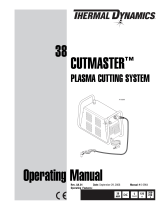 Thermal Dynamics 38 CUTMASTER™ Plasma Cutting System Manuel utilisateur
Thermal Dynamics 38 CUTMASTER™ Plasma Cutting System Manuel utilisateur
-
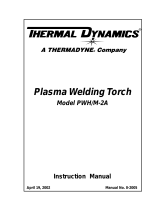 Thermal Dynamics Plasma Welding Torch Model PWH/M-2A Manuel utilisateur
Thermal Dynamics Plasma Welding Torch Model PWH/M-2A Manuel utilisateur
-
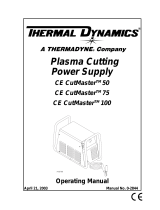 Thermal Dynamics Plasma Cutting Power Supply CE CutMaster™ 50 CE CutMaster™ 75 CE CutMaster™ 100 Manuel utilisateur
Thermal Dynamics Plasma Cutting Power Supply CE CutMaster™ 50 CE CutMaster™ 75 CE CutMaster™ 100 Manuel utilisateur
-
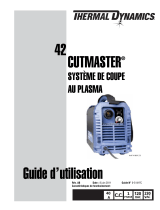 Thermal Dynamics 42 CUTMASTER® Plasma Cutting System Manuel utilisateur
Thermal Dynamics 42 CUTMASTER® Plasma Cutting System Manuel utilisateur
-
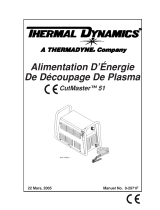 Thermal Dynamics CE CutMaster™ 51 Plasma Cutting Power Supply Manuel utilisateur
Thermal Dynamics CE CutMaster™ 51 Plasma Cutting Power Supply Manuel utilisateur
-
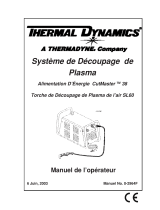 Thermal Dynamics Plasma Cutting System CutMaster™ 38 Power Supply SL60 Plasma Cutting Torch Manuel utilisateur
Thermal Dynamics Plasma Cutting System CutMaster™ 38 Power Supply SL60 Plasma Cutting Torch Manuel utilisateur
-
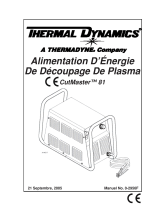 Thermal Dynamics CE CutMaster™ 81 Plasma Cutting Power Supply Manuel utilisateur
Thermal Dynamics CE CutMaster™ 81 Plasma Cutting Power Supply Manuel utilisateur
-
Thermal Dynamics Thermal Dynamics an ESAB Brand Cutmaster 40 PLASMA CUTTING SYSTEM Manuel utilisateur
-
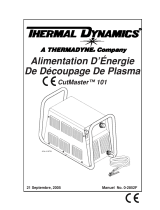 Thermal Dynamics CE CutMaster™ 81 Plasma Cutting Power Supply Manuel utilisateur
Thermal Dynamics CE CutMaster™ 81 Plasma Cutting Power Supply Manuel utilisateur
-
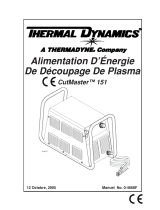 Thermal Dynamics CE CutMaster™ 151 Plasma Cutting Power Supply Manuel utilisateur
Thermal Dynamics CE CutMaster™ 151 Plasma Cutting Power Supply Manuel utilisateur
Autres documents
-
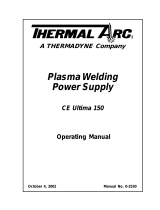 Thermal Arc Plasma Welding Power Supply Manuel utilisateur
Thermal Arc Plasma Welding Power Supply Manuel utilisateur
-
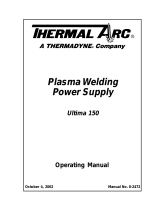 Thermal Arc Plasma Welding Power Supply Manuel utilisateur
Thermal Arc Plasma Welding Power Supply Manuel utilisateur
-
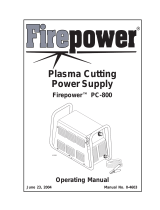 Firepower Plasma Cutting Power Supply Firepower™ PC-800 Manuel utilisateur
Firepower Plasma Cutting Power Supply Firepower™ PC-800 Manuel utilisateur
-
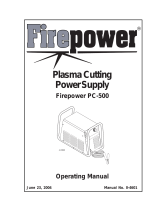 Firepower Plasma Cutting Power Supply Firepower PC-500 Manuel utilisateur
Firepower Plasma Cutting Power Supply Firepower PC-500 Manuel utilisateur
-
ESAB DRAG-GUN™ Plasma Cutter with Built-In Air Manuel utilisateur
-
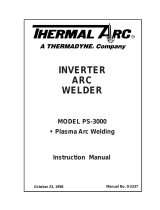 Thermal Arc Inverter Arc Welder Model PS-3000 Manuel utilisateur
Thermal Arc Inverter Arc Welder Model PS-3000 Manuel utilisateur
-
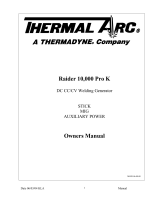 Thermal Arc 000 Pro K Le manuel du propriétaire
Thermal Arc 000 Pro K Le manuel du propriétaire
-
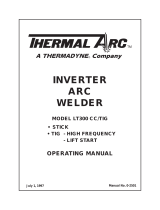 Thermal Arc Inverter Arc Welder Model LT300 CC/Tig Manuel utilisateur
Thermal Arc Inverter Arc Welder Model LT300 CC/Tig Manuel utilisateur
-
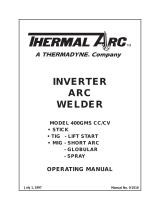 Thermal Arc Inverter Arc Welder Model 400GMS CC/CV Manuel utilisateur
Thermal Arc Inverter Arc Welder Model 400GMS CC/CV Manuel utilisateur
-
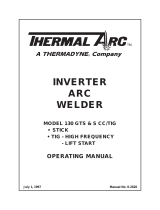 Thermal Arc Inverter Arc Welder Model 130 GTS & S CC/TIG Manuel utilisateur
Thermal Arc Inverter Arc Welder Model 130 GTS & S CC/TIG Manuel utilisateur































































